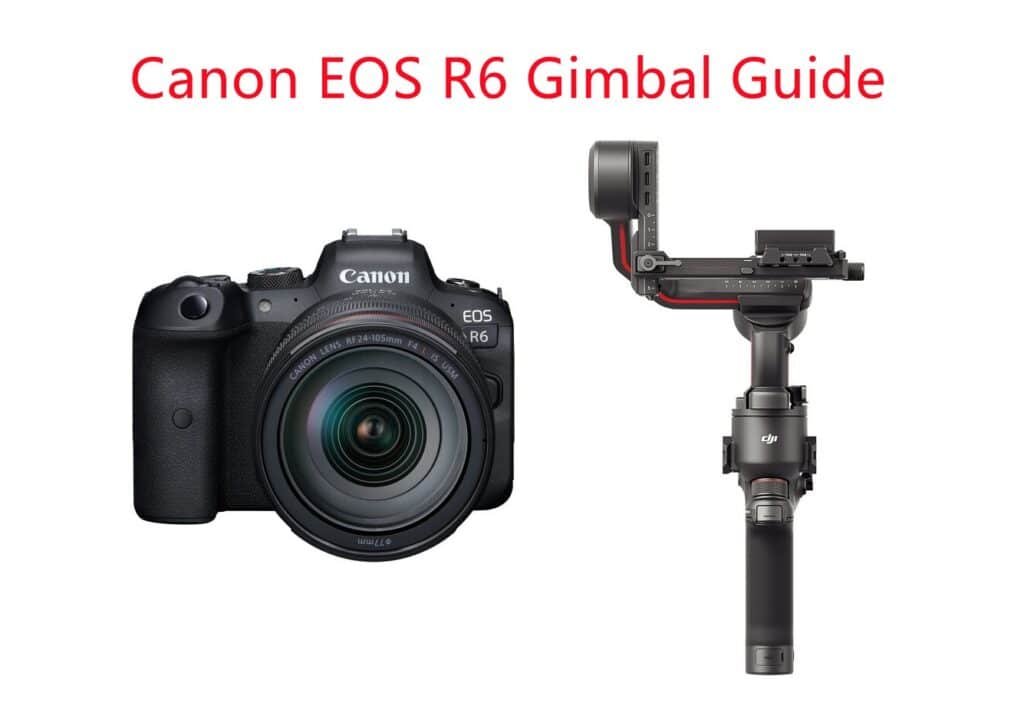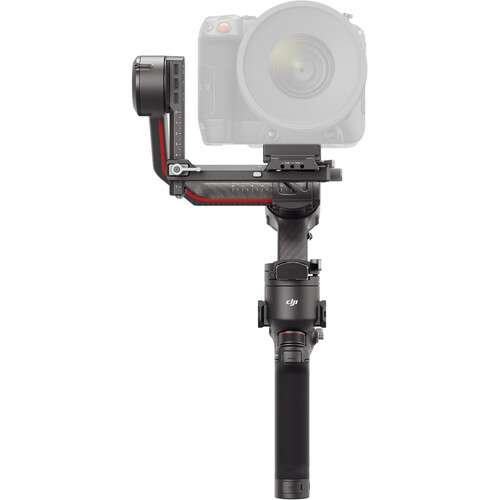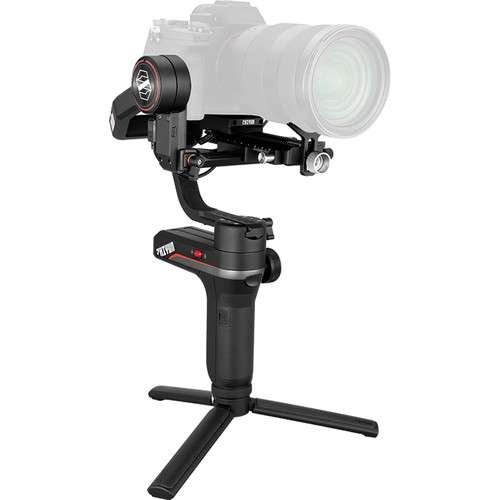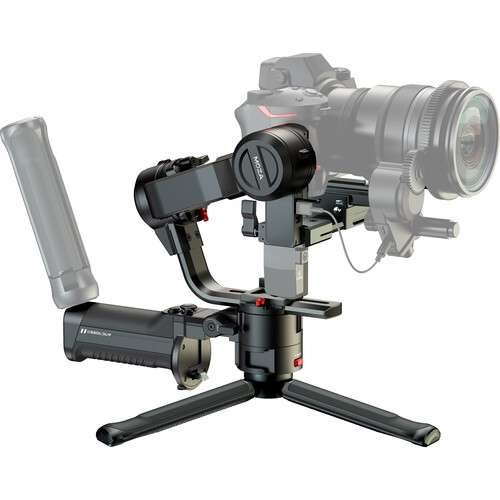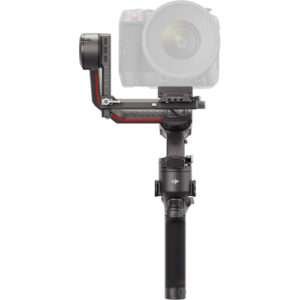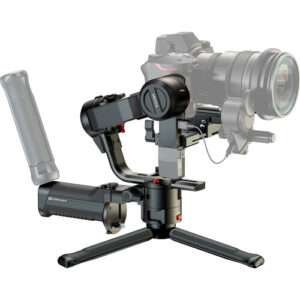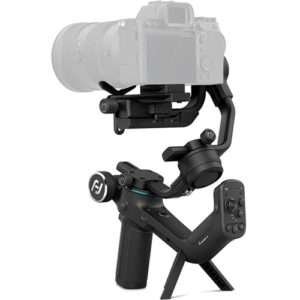Best Gimbals for Canon EOS R6
Designed for both photographers and video content creators, the Canon EOS R6 mirrorless camera is perfect for photographing high-speed action sports as well as filming 4K cinematic video with ease. In addition, featuring a bright and detailed 0.5″ 3.69m-dot electronic viewfinder with a high 120 fps refresh rate and a rear 3.0″ 1.62m-dot touchscreen LCD with a vari-angle design, the Canon EOS R6 is an ideal tool for vlogging and working from high and low angles.
To fully utilize the EOS R6’s capabilities, a gimbal is a must-have accessory for stabilizing shots and creating smooth cinematic movements. However, finding the right gimbal for your Canon EOS R6 can be a daunting task, especially if you’re not familiar with the different features and specifications that go into selecting a high-quality gimbal. Luckily, we’ve done the hard work for you and compiled a comprehensive list of the best gimbals for the Canon EOS R6.
Our selection of gimbals has undergone extensive research and testing to ensure optimal performance, durability, and ease of use. We’ve taken into account various aspects such as maximum payload capacity, battery runtime, charging time, weight, connection types, display screens, and smartphone app compatibility to provide you with a well-rounded selection. In the detailed reviews that follow, we provide an in-depth analysis of each gimbal, highlighting its advantages and disadvantages so that you can make an informed decision on which one is the best fit for your photography style.
Whether you’re a seasoned professional or just starting out, our recommended list of gimbals for Canon EOS R6 is sure to elevate your photography and videography game. So, without further ado, let’s dive into the detailed reviews of the best gimbals for Canon EOS R6 to help you make the best choice for your needs.
Canon EOS R6 Store Links: B&H, Adorama.
Best Gimbals for Canon EOS R6
After thorough research and personal experience, we’ve compiled a list of the top recommended gimbals for the Canon EOS R6 mirrorless camera. These gimbals were carefully selected for their outstanding performance, stability, and versatility, offering an improved photography and videography experience.
Our detailed reviews offer a comprehensive breakdown of each of the recommended gimbals, including their essential features, pros, and cons. Whether you’re a seasoned filmmaker or just starting out, you’re bound to find a gimbal that suits your particular requirements and budget.
Image | Product | Features | Price |
| |||
| |||
| |||
| |||
| |||
|
1. DJI RS 3
Best Overall Gimbal
DJI RS 3 Key Features:
- Max. Payload: 6.6 lb / 3 kg
- Battery Runtime: 12 Hours (Removable, 3000 mAh)
- Battery Charging Time: 2.5 Hours (Supports 18W PD Fast-charging)
- Connections: Bluetooth 5.0, USB-C
- Display: 1.8-inch OLED Touchscreen
- Smartphone App: Yes
- Compatiblitle Cameras: Click Here to Check
- Weight: 2.2 lb / 990 g
- Dimensions: 410 x 260 x 195 mm
- Warranty: 1 year
- Special Feature: 3rd-Gen RS Stabilization Algorithm, Instant Mode Switching, Supports Wireless Image Transmitter, Motion Control with Smartphone, PD Fast Charging, Multiple Operation Modes, Fine-Tuning Knob on Tilt Axis, Wireless Shutter Control, Lots of accessories
As a Canon EOS R6 user, I have had the pleasure of using the DJI RS 3 gimbal, and I can confidently say that it is the best overall gimbal available in the market today. It is an ideal choice for mirrorless shooters who prefer lightweight equipment, including elopement wedding filmmakers and travel vloggers.
One of the most significant advantages of the DJI RS 3 is its lightweight design, which weighs only 2.2 lb (990 g) and can carry a maximum payload of 6.6 lb (3 kg). The gimbal’s size and weight make it perfect for travel, and it never feels cumbersome to carry around. Additionally, its advanced 1.8-inch OLED touchscreen display provides users with an easy-to-use interface for controlling the gimbal and camera settings.
The DJI RS 3’s instant mode switching feature is a standout, allowing you to switch between different modes in a split second. Its customizable front dial and Bluetooth shutter button provide even more control options, while the wireless and integrated controls make it easy to use the gimbal in a variety of settings.
Another significant advantage of the DJI RS 3 is its 12-hour operating time and PD fast charging, ensuring you never run out of battery in the middle of a shoot. Additionally, the gimbal’s fine-tuning knob on the tilt axis allows you to make precise adjustments to your camera’s tilt, while the multiple operation modes and wireless shutter control provide even more creative control.
However, one limitation of the DJI RS 3 is that long lenses may not fit comfortably, so it may not be suitable for all types of photography. Nevertheless, this is a minor drawback, and the DJI RS 3 remains an outstanding choice for anyone looking for a versatile, reliable, and feature-packed gimbal for their Canon EOS R6 camera.
Pros
- 1.8-inch OLED Color touchscreen
- Up to 3 kg payload
- Beyond Smooth
- Instant Mode Switching
- Customizable Front Dial
- Bluetooth shutter button
- Stabilizes full-frame systems
- Wireless and integrated controls
- Quick-Release Design
- 12-Hour Operating Time + Fast Charging
Cons
- Long lenses may not fit
DJI RS 3 Gimbal Stabilizer at B&H, Adorama.
DJI RS 3 Gimbal Stabilizer Combo at B&H, Adorama.
2. DJI RS 3 Mini
A Lightweight Gimbal for Mirrorless Cameras
DJI RS 3 Mini Key Features:
- Max. Payload: 2 kg (4.4 ls)
- Battery Runtime: 10 Hours
- Battery Charging Time: 2.5 Hours
- Battery Capacity: 2450 mAh / 17.64 Wh
- Display: 1.4″ Full Color Touchscreen
- Smartphone App: Yes
- Compatiblitle Cameras: Click Here to Check
- Folded size: 323 x 195 x 98 mm
- Weight: 1.9 lb / 850 g (with Camera Plate)
- Warranty: 1 year
- Special Feature: 3rd Gen RS Stabilization Algorithm, Wireless Camera Control via Bluetooth, Horizontal & Vertical Modes, Panorama, Timelapse & Tracking Functions, NATO Rail for Handles & Accessories, Includes Extended Grip/Tripod
If you’re looking for a lightweight, compact gimbal for your Canon EOS R6, the DJI RS 3 Mini might be the perfect option for you. As a user of the gimbal, I can attest to its effectiveness and portability.
The DJI RS 3 Mini is specifically designed for mirrorless cameras, making it a great option for Canon EOS R6 users. Its lightweight design, weighing less than 800 g / 1.8 lbs, and a payload capacity of up to 2 kg / 4.4 lbs, make it easy to carry around, even on long trips or hikes. The gimbal’s advanced 3rd generation stabilization algorithm helps create smooth, cinematic footage, and the wireless camera control via Bluetooth makes it easy to adjust settings on the fly.
One of the standout features of the RS 3 Mini is its 1.4-inch color touchscreen, which makes navigating the menus and settings a breeze. The gimbal also includes a NATO rail for handles and accessories, as well as an extended grip/tripod, providing added versatility for a range of shooting scenarios.
The RS 3 Mini offers several shooting modes, including horizontal and vertical modes, panorama, timelapse, and tracking functions. These modes can be accessed and adjusted via the color touchscreen or the DJI smartphone app, which allows for even more control over your footage.
However, there are some drawbacks to the RS 3 Mini. For instance, when using cameras with swing-out LCD screens, the screen can be blocked in portrait mode, which may hinder your shooting capabilities. Additionally, the accessory system is not as robust as its larger siblings, the RS 2 and RS 3, which may limit the options for adding accessories to the gimbal.
In conclusion, the DJI RS 3 Mini is a great option for users of the Canon EOS R6 who are looking for a lightweight, compact, and easy-to-use gimbal. While it may not have all the features of its larger siblings, the RS 3 Mini is a solid entry-level option that can deliver smooth, cinematic footage on the go.
Pros
- 2kg payload allows for pro lenses
- Color touch display menu
- Easy setup for landscape and portrait video
- Powered stabilization
- Arca-Swiss mounting plate
- Bluetooth camera control link
Cons
- Swing-out LCDs blocked in portrait mode
- Accessory system not as robust as bigger RS 3
- Smartphone activation required
- Doesn’t include onboard video light
DJI RS 3 Mini Gimbal Stabilizer at B&H, Adorama.
3. DJI RS 3 Pro
High Payload Capacity, Most High-end Gimbal
DJI RS 3 Pro Key Features:
- Max. Payload: 9.9 lb / 4.5 kg
- Battery Runtime: 12 Hours (Removable, 1950 mAh)
- Battery Charging Time: 1.5 Hours (24W Fast-charging (QC 2.0 or PD))
- Connections: Bluetooth 5.0, USB-C
- Display: 1.8-inch OLED Touchscreen
- Smartphone App: Yes
- Compatiblitle Cameras: Click Here to Check
- Weight: 2.5 lb / 1143 g
- Dimensions: 415 x 218 x 195 mm, 276 x 268 x 68 mm (Folded)
- Warranty: 1 year
- Special Feature: LiDAR Focusing System, All-New Focus Motor, Long-Range Wireless Transmission, Extended carbon fiber material, 3rd-Gen RS Stabilization Algorithm, Automated Axis Locks, Wireless Shutter Control, Instant Mode Switching, Monitoring via Smartphone, Lots of accesories
As a professional videographer who has been using the DJI RS 3 Pro gimbal stabilizer for my Canon EOS R6, I can say with confidence that this device is easily the most advanced gimbal stabilizer I’ve used.
One of the key features that makes the DJI RS 3 Pro stand out is its high payload capacity, which can support up to 9.9 lbs (4.5 kg) of weight. This is perfect for heavier camera and lens setups, and it allows for Hollywood-style camera moves that were previously only possible with larger and more expensive equipment. The gimbal’s construction is made of carbon fiber, which is lightweight but strong, and can withstand a lot of wear and tear.
The gimbal comes with a long battery life that can last up to 12 hours and can be charged quickly with the 24W fast-charging system that supports QC 2.0 or PD. The 1.8-inch OLED touchscreen is also a significant improvement over previous Ronin models, and it’s brighter and easier to see even in bright sunlight.
Setting up the DJI RS 3 Pro can take some time, especially if it’s your first time using a gimbal stabilizer. However, once you get the hang of it, the device is intuitive and user-friendly. The physical Mode Switch and Tilt Balance Fine-Tuning Knob are useful for quickly changing camera modes and adjusting the tilt balance. Additionally, the gimbal features the 3rd-Gen RS Stabilization Algorithm, which ensures smooth and stable shots, even when moving at high speeds.
The gimbal is also packed with other features such as ActiveTrack Pro support and the LiDAR Focusing System that enables accurate and reliable autofocus. This feature is especially handy when shooting moving subjects as it can automatically adjust the focus point in real-time, leaving you to focus on the shot.
Furthermore, the device supports the DJI SDK, making it possible to integrate it with other third-party applications. The gimbal also comes with wireless shutter control and can support a long-range wireless transmission for remote monitoring via smartphone. Additionally, the gimbal supports a wide range of accessories that can take your moviemaking to the next level.
The only downside to the DJI RS 3 Pro is its price. As a high-end gimbal stabilizer, it’s targeted towards professional videographers, and it comes with a hefty price tag. Additionally, some of the accessories that can enhance the device are also quite expensive.
Overall, the DJI RS 3 Pro gimbal stabilizer is an excellent choice for professional videographers who require a robust and reliable device that can support heavy camera and lens setups. It’s not the most affordable gimbal on the market, but the price is well worth the advanced features, stability, and quality of the product.
Pros
- Supports up to 4.5kg (10 lbs)
- Active track Pro support and 1.8-inch OLED touch screen
- Long battery life and fast charging
- Huge potential through accessories
- Strongest Carbon Fiber construction
- LiDAR focusing technology compatibility
- High-Bright Remote Monitoring
- Intuitive and user-friendly control
Cons
- Priced for pros
- Some accessories are equally expensive
DJI RS 3 Pro Gimbal Stabilizer at B&H, Adorama.
DJI RS 3 Pro Gimbal Stabilizer Combo at B&H, Adorama.
4. Zhiyun Weebill 3
Zhiyun Weebill 3 Key Features:
- Max. Payload: 14.33 lb / 6.5 kg
- Battery Runtime: 21 Hours (Non-removable, 2600 mAh)
- Battery Charging Time: 2 Hours (Supports PD Fast charging – USB-C Input)
- Connections: Bluetooth 5.0, USB-C
- Display: 0.96-inch OLED Touchscreen
- Smartphone App: Yes
- Compatiblitle Cameras: Click Here to Check
- Dimensions: 342 x 206.5 x 72.5 mm (Folded)
- Weight: 2.4 lb / 1.1 kg
- Warranty: 1 year
- Special Feature: Integrated Microphone and Fill Light, Dual Quick Release Plate System, Two Rosette Mounts with 1/4″-20 Threads, Tripod Extension, Control Wheel, Bluetooth and Wi-Fi Capabilities for App, Lots of Accessories
As a vlogger who frequently uses the Canon EOS R6, I was excited to try out the Zhiyun Weebill 3 gimbal. Overall, I found that the Weebill 3 is an excellent gimbal for its price point and is incredibly easy to use.
One of the biggest strengths of the Weebill 3 is its simplicity. The gimbal is small and lightweight, which makes it easy to carry around and set up quickly. The new wrist rest and sling grip also make it very comfortable to hold, even for extended periods of time.
In terms of performance, the Weebill 3 is capable of supporting heavier payloads than many other compact gimbals on the market, with a maximum payload of 14.33 lb / 6.5 kg. This makes it a great choice for those who use heavier cameras like the Canon EOS R6. The motor is also very powerful and provides excellent stabilization for smooth footage.
Another notable feature of the Weebill 3 is the built-in microphone and fill light. These are designed for run-and-gun filmmaking, and they work very well for quick shoots where you don’t want to carry around extra equipment. The gimbal also has a 21-hour battery life, which is incredibly impressive and should be more than enough for a full day of shooting.
In terms of accessories, the Weebill 3 comes with a variety of useful items, including two rosette mounts with 1/4″-20 threads, a tripod extension, and various control cables. There is also a smartphone app available for the Weebill 3, which allows you to control the gimbal remotely via Bluetooth and Wi-Fi.
There are some drawbacks to the Weebill 3, however. The OLED screen is quite small and does not have a touchscreen, which can make it a bit challenging to navigate the settings. Additionally, there is no flip-out screen, which can make it difficult to see what you’re shooting when the camera is mounted on the gimbal. Finally, the setup can be a bit confusing for beginners, as there are a lot of options and settings to navigate.
Overall, if you’re looking for a compact gimbal that can support heavier payloads and comes with some convenient built-in features, the Zhiyun Weebill 3 is an excellent choice. While it may lack some of the more advanced features of the DJI RS 2, it is significantly cheaper and still performs very well. The Weebill 3’s simplicity and ease of use make it a great option for those who are just starting out with gimbals or want something that’s more compact and portable.
Pros
- Incredibly comfortable
- Built-in light and microphone
- Super powerful 21 hours battery
- Handles heavy cameras
- Competitively priced
- Ergonomic wrist support
- Cheaper than the competition
- Double plate quick release with magnetic tool
- Powerful motor and stabilization
- Easy trigger and wheel control
- Extended handle grip and wrist support
Cons
- Small OLED screen
- No touchscreen
- No flip-out screen
- Setup was confusing for a beginner
Zhiyun WEEBILL-3 Gimbal Stabilizer at B&H, Adorama.
Zhiyun WEEBILL-3 Gimbal Stabilizer Combo at B&H, Adorama.
5. Moza AirCross 3
Moza AirCross 3 Key Features:
- Max. Payload: 7.1 lb / 3.2 kg
- Battery Runtime: 19 Hours (Non-removable, 3500 mAh)
- Battery Charging Time: 1.4 Hours
- Connections: Bluetooth 5.0, WIFI, USB-C
- Display: OLED Built-in Screen
- Smartphone App: Yes
- Compatiblitle Cameras: Click Here to Check
- Dimensions: 310 x 190 x 170 mm, 270 x 225 x 52 mm (Folded)
- Weight: 2.9 lb / 1.3 kg (without Handlebar)
- Warranty: 1 year
- Special Feature: 4 in 1 convertible design, Axis Locks for Simplified Balancing, Angled motor arm for clear camera view, 3* 1/4 Extension Holes, Manual Position 2.0 & Sports Mode 2.0, Wide Compatibility, Stable Algorithm, One Shutter Button Control for All, Upgraded UI Design, Folds down to size of A4 size paper
As a user of the Moza AirCross 3 gimbal with my Canon EOS R6 camera, I can say that this is a fantastic product that has met and exceeded my expectations. The AirCross 3’s unique convertible design and versatile shooting modes make it an incredibly useful tool for any video-maker.
The gimbal is very easy to set up, and balancing is a breeze with the Axis Locks feature. Once your camera is mounted and balanced, the AirCross 3 provides rock-solid stabilization. I was impressed with how well it handles even heavier lenses and accessories, such as my Canon 70-200mm f/2.8 lens. The angled motor arm also provides a clear view of the camera’s screen, which is a nice touch.
The AirCross 3’s battery life is impressive, lasting up to 19 hours of use, which is more than enough for a full day of shooting. However, it would be helpful if there was a battery level indicator, so you know when to recharge before the battery dies. The charging time is quick, taking only 1.4 hours for a full charge.
The OLED built-in screen is very useful for accessing different modes and settings, and the upgraded UI design is a welcome improvement. I found the controls to be straightforward and easy to understand. However, the user interface could be improved, especially for those who are not familiar with gimbals.
The AirCross 3 is lightweight, making it easy to carry around all day without fatigue. The foldable design is also a big plus, making it easy to store and transport. The grip is comfortable to hold, and the build quality is excellent, despite the black matte finish that does scratch easily.
Overall, the Moza AirCross 3 is an excellent investment for anyone looking for a reliable and versatile gimbal for their mirrorless or DSLR camera. The four-in-one convertible design is a standout feature that allows you to configure the gimbal in the way that best suits your filming situation. The price is reasonable, considering the features and performance you get, although the weight could be a problem with a heavy camera.
Pros
- Great build quality
- 4 in 1 convertible design
- Easy vertical/horizontal mode switch
- Can accommodate large cameras
- Optional Active tracking module
- Enhance battery power and quick charging
- Higher payload and lightest weight
- Straightforward control and handling
Cons
- The user interface could be improved
- No battery level indicator
- Weight could be a problem with a heavy camera
Moza AirCross 3 Gimbal Stabilizer at B&H, Adorama.
6. Feiyu SCORP-C
Affordable Gimbal with excellent performance
Feiyu SCORP-C Key Features:
- Max. Payload: 5.5 lb / 2.5 kg
- Battery Runtime: 13 Hours (Non-removable, 2500 mAh)
- Battery Charging Time: 1.6 Hours
- Connections: Bluetooth, USB-C
- Display: No
- Smartphone App: Yes
- Compatiblitle Cameras: Click Here to Check
- Weight: 2.7 lb / 1.2 kg (with Camera Plate)
- Dimensions: 280.8 x 266.2 x 71.3 mm (Folded), 314.4 x 243.3 x 210.7 mm
- Warranty: 1 year
- Special Feature: Control via Buttons and App, Quick Release Camera Plate, Five Follow Modes for Customized Control, Three 1/4″-20 Mounting Threads, USB Type-C Camera Connections, Macromolecular Resin, Aluminum Alloy, Motorized 3-Axis Gimbal, Folding Aileron Bracket, Various shooting modes on Feiyu SCORP APP, Various Automated Modes
The Feiyu SCORP-C is a lightweight and affordable gimbal, making it an attractive option for beginner videographers or those on a tight budget. It supports up to a 2.5kg payload, which is sufficient for most mirrorless and DSLR cameras, including the Canon EOS R6. The built-in battery provides up to 13 hours of runtime, and it can be charged quickly in 1.6 hours via the USB Type-C port.
The gimbal is made of macromolecular resin and aluminum alloy, which makes it sturdy yet lightweight. The folding aileron bracket makes it easy to store and transport. The gimbal’s design features three 1/4″-20 mounting threads that allow you to attach various accessories.
The Feiyu SCORP-C offers five follow modes for customized control, including pan follow, tilt follow, all follow, locked, and POV. The quick-release camera plate allows for easy setup and balancing. The gimbal can be controlled via buttons and the Feiyu SCORP app, which offers various shooting modes, including face tracking, time-lapse, and panorama.
In terms of performance, the Feiyu SCORP-C is stable and provides smooth footage. The underslung grip is comfortable, and the motorized 3-axis gimbal helps to eliminate camera shake. However, the camera’s battery life may be impacted by the weight of the camera when mounted on the gimbal.
One area where the Feiyu SCORP-C falls short is the app. Many users have reported that the app needs improvement in terms of stability and user-friendliness. Additionally, the lack of a built-in display means that you have to rely on the app to access settings and view real-time footage.
Overall, the Feiyu SCORP-C is a solid budget gimbal that offers good performance and features. However, the app needs improvement, and the weight of the camera may impact battery life. If you’re on a tight budget and looking for an affordable gimbal, the Feiyu SCORP-C is a good option.
Pros
- Balance and setup is far easier
- Underslung grip is comfortable
- Incredibly stable and smooth
- Longer battery runtime with fast charging
- Exceptionally economical
Cons
- Camera life dramatically impacted by weight
- App needs a LOT of work
Feiyu SCORP-C 3-Axis Gimbal Stabilizer at B&H.
We appreciate you taking the time to read our recommended gimbals for the Canon EOS R6. We hope that this guide has been informative and assisted you in your search for the ideal gimbal.
If you have any comments or further suggestions on gimbals that we should consider for testing, we would appreciate hearing from you. We constantly strive to enhance our recommendations and guides, and your feedback is valuable to us.
Additionally, if you have any personal experiences or insights regarding any of the gimbals we featured in this article, we would welcome your input. Your feedback can help future readers make informed decisions and choose the best gimbal to suit their needs.
Read more:
- Best Lenses for Canon EOS R6
- Best Memory Cards for Canon EOS R6
- Best Gimbals for Canon EOS R5
- Best Gimbals for Mirrorless Cameras
- Best Smartphone Gimbals
- Best Cameras for Wedding Photography
